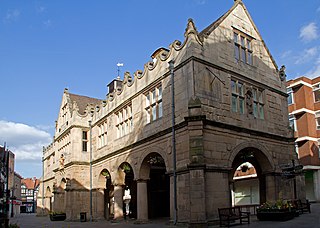
The Old Market Hall is an Elizabethan building situated in the town centre of Shrewsbury, the county town of Shropshire, England. It is a Grade I listed building.

Holme Hall near Bakewell, Derbyshire, is a privately owned 17th-century country house. It is a Grade I listed building.

Horbury Town Hall is a former municipal building in Westfield Road, Horbury, West Yorkshire, England. The structure, which is now used as business centre, is a locally listed building.

Woburn Town Hall is a municipal building in the Market Place, Woburn, Bedfordshire, England. The town hall, which has largely been converted for retail use, is a Grade II listed building.

The Old Town Hall is a municipal building in the Market Square, Leighton Buzzard, Bedfordshire, England. The town hall, which is currently used as a restaurant, is a Grade II listed building.

Ashbourne Town Hall is a municipal building in the Market Place, Ashbourne, Derbyshire, England. The town hall, which is the meeting place of Ashbourne Town Council, is a Grade II listed building.

St Marychurch Town Hall is a municipal building in Fore Street, St Marychurch, Devon, England. The town hall, which is now used as a block of apartments, is a Grade II listed building.

Redesdale Hall, also referred to as Moreton-in-Marsh Town Hall, is a municipal building in the High Street, Moreton-in-Marsh, Gloucestershire, England. The building, which is used as an events venue, is a Grade II listed building.

Ledbury Market Hall, also known as Ledbury Town Hall, is a municipal building in the High Street in Ledbury, Herefordshire, England. The structure, which is used as an events venue, is a Grade I listed building.

The Old Town Hall is a municipal building in the Market Place in Somerton, Somerset, England. The building, which is used as an arts centre, is a Grade II listed building.

Banchory Town Hall is a municipal structure in the High Street, Banchory, Aberdeenshire, Scotland. The structure is primarily used as a community events venue.

Kinross Town Hall forms part of a complex of municipal buildings in the High Street, Kinross, Perth and Kinross, Scotland. The town hall, which has been converted for residential use, is a Category B listed building.

Lockerbie Town Hall is a municipal building in the High Street in Lockerbie, Dumfries and Galloway, Scotland. The structure, which is used as a venue for the provision of local services, is a Category A listed building.

Darvel Town Hall is a municipal building in West Main Street, Darvel, East Ayrshire, Scotland. The structure, which is used as a library and a community events venue, is a Category B listed building.

Ince-in-Makerfield Town Hall, also known as Ince-in-Makerfield Council Offices, is a municipal building in Ince Green Lane, Ince-in-Makerfield, Greater Manchester, England. The building is currently used as a children's nursery.

The Corn Exchange is a commercial building in the High Street, Dalkeith, Midlothian, Scotland. The structure, which is now used as a museum, is a Category A listed building.

The Corn Exchange is a commercial building in Broad Street, Stamford, Lincolnshire, England. The structure was refurbished between 2001 and 2008 and is now used as a theatre.

Swadlincote Town Hall is a municipal building in The Delph in Swadlincote, a town in Derbyshire in England. The building, which serves a community events venue, is a Grade II listed building.

The Old Town Hall, also known as The Buttermarket, is a former municipal building in King Street, Bakewell, a town in Derbyshire, England. The building, which is currently in retail use, is a Grade II listed building.

Bakewell Market Hall is a historic building in the town of Bakewell, in Derbyshire, in England.





















